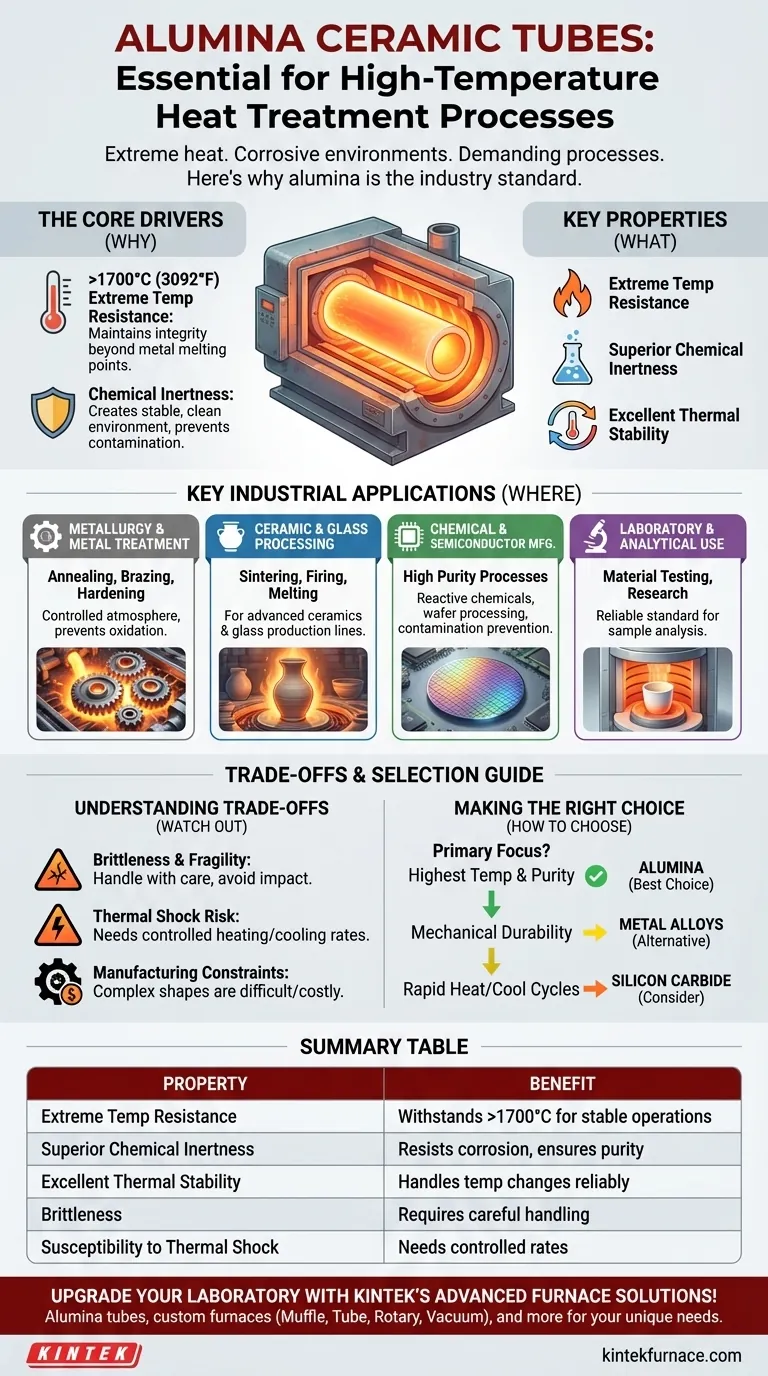In short, alumina ceramic tubes are primarily used in high-temperature furnace applications for metal heat treatment, ceramic sintering, and glass melting. Their selection is driven by an exceptional ability to withstand extreme heat and corrosive environments where most other materials would degrade or fail.
The core reason for using alumina ceramic tubes is their unique combination of extreme temperature resistance and chemical inertness. This allows them to create a stable, clean, and controlled environment for heat-treating materials without reacting with them, even at temperatures exceeding 1700°C (3092°F).
The Core Properties Driving Adoption
To understand why alumina is a go-to material, we must look at the specific properties that make it uniquely suited for harsh thermal environments.
Extreme Temperature Resistance
Alumina (Aluminum Oxide, Al₂O₃) has a very high melting point, allowing it to maintain its structural integrity at temperatures that would melt or weaken most metals. This makes it an ideal containment vessel or radiant tube inside a furnace.
Superior Chemical Inertness
These tubes are highly resistant to chemical attack from alkalis, acids, and other corrosive agents. This is critical in metallurgy and chemical processing, where the tube must not react with or contaminate the product being heated.
Excellent Thermal Stability
Alumina exhibits good resistance to thermal shock, meaning it can handle significant temperature changes without cracking. While not impervious, its stability allows for reliable cycling in furnace operations.
Key Industrial Applications
These properties translate directly into use cases across several demanding industries. The alumina tube often acts as a protective sleeve, process chamber, or radiant heating element support.
Metallurgy and Metal Treatment
In processes like annealing, brazing, and hardening, a controlled atmosphere is essential. Alumina tubes provide a non-reactive chamber to hold the metal parts, preventing oxidation and ensuring the integrity of the heat treatment.
Ceramic and Glass Processing
Alumina tubes are used extensively for firing or sintering other advanced ceramics, such as bioceramics and CIM (Ceramic Injection Molding) components. In glass manufacturing, they are used in melting and float glass production lines where they endure constant high temperatures.
Chemical and Semiconductor Manufacturing
For producing highly reactive chemicals like aluminum trichloride or processing silicon wafers in semiconductor fabrication, purity is paramount. Alumina tubes provide an inert environment, preventing contamination that could ruin the final product.
Laboratory and Analytical Use
Nearly every high-temperature laboratory furnace relies on alumina tubes. Their reliability and non-contaminating nature make them the standard for material testing, sample analysis, and research applications.
Understanding the Trade-offs
While highly effective, alumina is not a universal solution. Understanding its limitations is key to successful implementation.
Brittleness and Mechanical Fragility
Alumina is a ceramic, and therefore hard but brittle. It cannot withstand mechanical impact, bending, or high tensile stress like a metal alloy can. Careful handling and support design are critical.
Susceptibility to Extreme Thermal Shock
While thermally stable, very rapid and uneven temperature changes can still cause fractures. A controlled ramp-up and cool-down rate is often necessary for furnace operations to prolong the life of the tube.
Manufacturing and Cost Constraints
Complex shapes are more difficult and expensive to produce from alumina compared to metals. While straight tubes are common and affordable, custom geometries require specialized manufacturing processes.
Making the Right Choice for Your Process
Your choice of material depends entirely on the specific demands of your application.
- If your primary focus is operating at the highest possible temperatures with maximum chemical purity: Alumina ceramic is an industry-standard and often the best choice.
- If your primary focus is mechanical durability and impact resistance: You should consider high-temperature metal alloys or design a system that mechanically protects the alumina tube.
- If your primary focus involves extremely rapid heating and cooling cycles: Evaluate the specific grade of alumina or consider alternative materials like silicon carbide, which may offer better thermal shock resistance.
Ultimately, selecting the right material is a matter of aligning its known properties with your specific operational requirements.
Summary Table:
| Property | Benefit |
|---|---|
| Extreme Temperature Resistance | Withstands temperatures over 1700°C for stable furnace operations |
| Superior Chemical Inertness | Resists corrosion, ensuring purity in metallurgy and chemical processes |
| Excellent Thermal Stability | Handles temperature changes reliably, reducing risk of cracking |
| Brittleness | Requires careful handling to avoid mechanical damage |
| Susceptibility to Thermal Shock | Needs controlled heating/cooling rates for longevity |
Upgrade your laboratory with KINTEK's advanced high-temperature furnace solutions! Leveraging exceptional R&D and in-house manufacturing, we provide alumina ceramic tubes and custom furnace systems—including Muffle, Tube, Rotary, Vacuum & Atmosphere Furnaces, and CVD/PECVD Systems—to precisely meet your unique experimental needs in metallurgy, ceramics, and glass processing. Contact us today to enhance your heat treatment processes with reliable, high-performance equipment tailored for your success!
Visual Guide

Related Products
- 1400℃ High Temperature Laboratory Tube Furnace with Quartz and Alumina Tube
- 1700℃ High Temperature Laboratory Tube Furnace with Quartz or Alumina Tube
- High Pressure Laboratory Vacuum Tube Furnace Quartz Tubular Furnace
- Split Multi Heating Zone Rotary Tube Furnace Rotating Tube Furnace
- Laboratory Muffle Oven Furnace with Bottom Lifting
People Also Ask
- What is a tubular furnace? Precision Heating for Lab and Industrial Applications
- What materials are used for the tube chamber in tubular furnaces? Choose the Right Tube for Your Lab's High-Temp Needs
- What types of production processes benefit from the thermal uniformity of tube furnaces? Enhance Precision in Material Processing
- In which industries is the tube furnace commonly used? Essential for Materials Science, Energy, and More
- How do roller kilns and tube furnaces differ in their use of Alumina ceramic tubes? Compare Transport vs. Containment



















